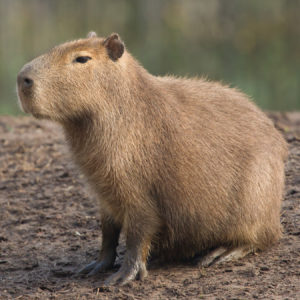Capybara

Scientific Name: Hydrochoerus hydrochaeris
IUCN (Red List) Status: Least Concern (LC)
The capybara has a heavy, barrel-shaped body and short head, with reddish-brown fur on the upper part of its body that turns yellowish-brown underneath. Its sweat glands can be found in the surface of the hairy portions of its skin, an unusual trait among rodents. The animal lacks down hair, and its guard hair differs little from over hair.
Adult capybaras grow to 106 to 134 cm in length, stand 50 to 62 cm tall at the withers, and typically weigh 35 to 66 kg, with an average in the Venezuelan llanos of 48.9 kg. Females are slightly heavier than males. The top recorded weights are 91 kg for a wild female from Brazil and 73.5 kg for a wild male from Uruguay.
Capybaras have slightly webbed feet and vestigial tails. Their hind legs are slightly longer than their forelegs; they have three toes on their rear feet and four toes on their front feet. Their muzzles are blunt, with nostrils, and the eyes and ears are near the top of their heads.
Habitat: Forest, Savanna, Wetlands (inland). only in habitat close to water including marshes, estuaries, and along rivers and streams.
Animal Location: South American Forest
Reproduction: The species breeds throughout the year, usually with a single breeding cycle. Gestation lasts up to 120 days after which an average of 3.5 young are born. They live in large groups of extended family members, with group size varying from 2 to 30 individuals with one dominant breeding male. The mating system is one of resource defence polygyny, where males defend access to foraging resources associated with bodies of water
Interesting Fact: They are diurnal or nocturnal depending on hunting pressure and the season


